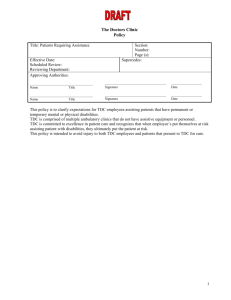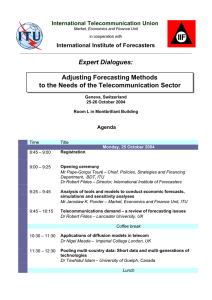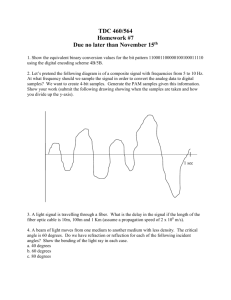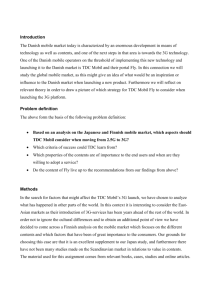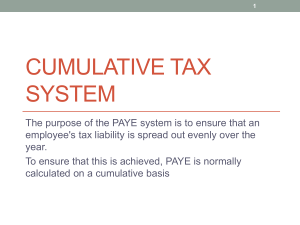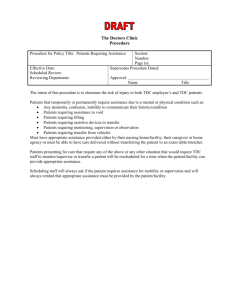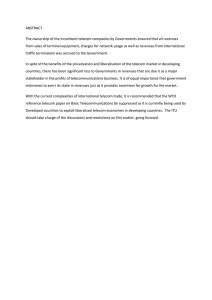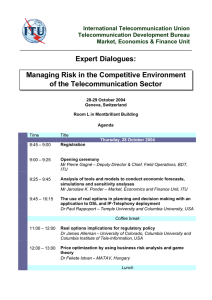Competition Policy in Telecommunications: The Case of Denmark
advertisement
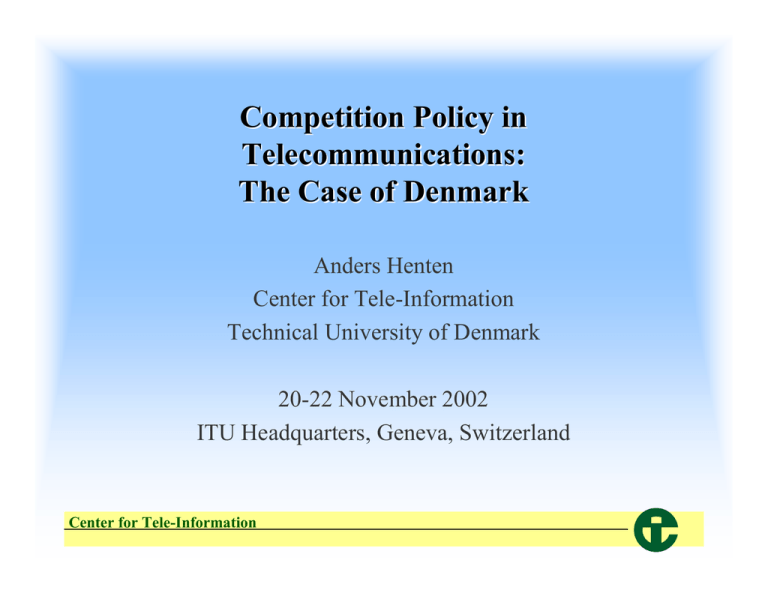
Competition Policy in Telecommunications: The Case of Denmark Anders Henten Center for Tele-Information Technical University of Denmark 20-22 November 2002 ITU Headquarters, Geneva, Switzerland Center for Tele-Information Basic Telecom Indicators (ITST) 1998 2000 June 2002 Fixed lines (000s) 3’496 3’835 3’909 Fixed lines/100 inhabitants 65.8 71.7 72.7 Mobile subscribers (000s) 1’931 3’363 3’154 Mobile/100 inhabitants 36.3 62.9 77.3 Internet subscribers (000s) n/a 1’684 2’282 Internet/100 inhabitants n/a 31.5 42.5 XDSL and cable modems (000s) n/a 67 354 XDSL+cable/100 inhabitants n/a 1.2 6.6 Center for Tele-Information TDC’ domestic market shares 2000-2002 (ITST) 1.H 2000 1.H 2001 1.H 2002 Fixed line subscriptions 98 90 86 Domestic traffic (fixed lines) 67 62 65 Mobile phone subscriptions 45 42 40 Domestic traffic (mobile) 45 42 42 International traffic (mobile) 39 40 42 SMS sent 30 28 27 Internet subscriptions 36 33 34 ADSL subscriptions n/a 55 79 Center for Tele-Information Major players • In general: TDC, Telia, Orange, Sonofon, Tele2, debitel • Fixed carrier selection: TDC, Tele2, Telia, Tiscali, Orange, Sonofon • International fixed traffic: TDC, Tele2, Telecom Plus, Telia, Global One • Mobile: TDC, Sonofon, Orange, Telia, debitel, Telmore • Internet: TDC, Tiscali, Tele2, Orange, Cybercity • ADSL: TDC, Cybercity, Tiscali Center for Tele-Information Penetration levels in comparison • Consistently among the top 10-15 countries internationally • Often 3rd-5th among the 5 Nordic countries • Doing well in high-speed and broadband access – but far behind South Korea and SFOBA Center for Tele-Information Broadband and high-speed access, % of households, July 2002 (ITST) ADSL + Cable modem + FWA + FTTB ADSL + Cable modem + FWA + FTTB + ISDN2 UK 3.5 8.6 Norway 6.4 43.5 Germany 7.3 30.5 Netherlands 11.7 32.7 Sweden 13.3 19.3 Denmark 13.7 25.7 SFOBA 30.0 43.3 South Korea 52.2 55.6 Center for Tele-Information Average monthly fixed line telephony expenditure, residential users, Euro, PPP, incl. VAT, August 2001 (CEC) Fixed Usage Total Sweden 14 18 32 Denmark 15 19 34 Luxembourg 20 14 34 Netherlands 18 19 37 Germany 13 26 39 Ireland 19 21 40 Finland 13 27 41 UK 16 26 42 France 14 30 44 USA 14 30 44 EU15 16 30 46 Center for Tele-Information Non-incumbent market shares, %, telephony outgoing minutes, June 2001 (CEC) Local Long-distance International Denmark 37 37 50 Germany 35 35 54 Austria 33 42 56 UK 28 49 69 Spain 10 15 14 Ireland 10 48 33 Luxembourg 7 n/a 26 Finland 7 68 46 France 3 21 26 Netherlands 1 4 30 Greece 0 0 0 Center for Tele-Information Comparison • Doing comparatively well – Penetration – Prices • Also in terms of competitive level • Discussion on reasons – Competition – Regulation Center for Tele-Information EU development • 1987 Greenbook, followed by stepwise liberalisation – 1987-1992: Limited liberalisation – 1992-1998: Extended • 1998 deadline: Full liberalisation • 1999 Review: Convergence and competition policy • 2002: Telecom package Center for Tele-Information Danish development • End 80s and beginning 90s: Following EU policies • Regional operators till 1991 • Creation of Tele Danmark to meet international competition • Change of policy 1994-1995: Best and cheapest • Total privatisation of Tele Danmark • Liberalisation 18 month ahead of EU deadline • Gone further than general EU legislation, e.g. USO and ULL • 1999: Several pipes to the home • 2002: Proposal for new telecom act (EU package) Center for Tele-Information Situation today • Competition i mobile and fixed traffic market (especially international) • Difficulties with competition i fixed access market • General opinion that regulation has been relatively effective • Also agreement that regulation can be rolled back • But concern about the speed among both competitors to TDC and representatives of residential and business users • Furthermore, concern that competitors are facing great difficulties Center for Tele-Information New Danish draft law • Extensive changes not required in Danish legislation • The greater reliance on general competition law based on competition analyses may lead in two opposite directions (weaker and stronger regulation) – Prohibition of bundling not for all providers, but for USOproviders and other SMP-providers – Roaming obligation only for SMP-providers – Retail market regulation not only of USO-providers but also other SMP-providers – Mobile termination as a separate market and therefore regulation of the mobile termination market Center for Tele-Information Institutional aspects 1 • ’Independent’ regulator since 1919 • Clear separation of policy development, regulation and operation • Institutions: – Ministry of Science Technoloy and Innovation – National IT and Telecom Agency – Telecommunications Consumer Board and Telecommunications Complaints Board – Self and co-regulation – Competition Authority Center for Tele-Information Institutional aspects 2 • Relation Ministry – NITA – Independence i regulatory matters – Expertise of the Ministry – Promotion of IT usage • Relationship NITA- Competition Authority – NCA-influence on • Maximum USO prices • RIO of SMP-providers • Accounting separation of SMP-providers – Competition law (general competition rules and abuse of dominant position), e.g. on predatory pricing Center for Tele-Information Challenges and assignments • Network access competition, e.g. implications of LRAIC prices • Greater reliance on competition law, including analyses of the different telecommunication markets • Convergence and its implications for privacy, security, IPR and consumer protection • Europeanization of the communication markets • Dual role of the regulator, emphasizing real independence Center for Tele-Information
